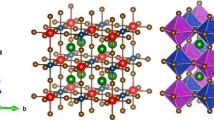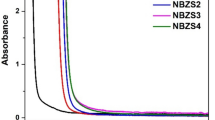Abstract
The interaction of ethylenediamine with iodic acid by the slow evaporation method at room temperature gives rise to the crystals of α-C2H10N2(IO3)2 and β-C2H10N2(IO3)2 denoted as α-EBI and β-EBI, respectively. The acentric crystal structures of both polymorphs that consist of [C2H10N2]2+ cations and [IO3]− anions connected together by N–H…O hydrogen bonds are discussed and compared. The optical properties of both polymorphs were determined using UV-vis diffuse reflectance spectroscopy (DRS) showing a wide transparency windows. The DFT calculations using the mixed B3PW91/[6–31 + (d, p), LanL2Dz] basis set of optimized geometries, dipole moment (μ), polarizability (α), first static hyperpolarizability (β), and population analysis were also reported. The experimental and theoretical IR and Raman spectra were compared, and the careful and complete assignment of the vibrational motions of both compounds was undertaken with the aid of potential energy distribution (PED) analysis. DSC and AC conductivity analysis revealed that α-C2H10N2(IO3)2 and β-C2H10N2(IO3)2 undergo a first-order phase transition around 360 K. The electrical σtot (ω, T) conductivity obeyed to Jonscher’s power law and the temperature dependence of the S(T) parameter showed that the electrical conductivity of both polymorph phases might be treated using the correlated barrier hopping (CBH) model.











Similar content being viewed by others
References
Andraud C et al (1994) Theoretical and experimental investigations of the nonlinear optical properties of vanillin, polyenovanillin, and bisvanillin derivatives. J Am Chem Soc 116:2094–2102
Nakano M et al (2002) Theoretical study on second hyperpolarizabilities of phenylacetylene dendrimer: toward an understanding of structure-property relation in NLO responses of fractal antenna dendrimers. J Am Chem Soc 124:9648–9655
Vijayan N et al (2006) Growth and characterization of nonlinear optical amino acid single crystal: L-alanine. Cryst Growth Des 6:2441–2445
Sankar R et al (2008) Synthesis, growth, and characterization of nonlinear optical material l-arginine iodate crystal. Mater Lett 62:133–136
Petrosyan AM et al (1998) Investigation of some new nonlinear optical crystals by means of NQR, IR and X-ray diffraction methods. Zeitschrift fur Naturforschung - Section A J Phys Sci 53a:528–536
Lucas BW (1984) Structure (neutron) of room-temperature phase III potassium iodate, KIO3. Acta Crystallogr Sect C Cryst StructCommun 40:1989–1992
Yagi K, Umezawa S (2001) EXAFS study of phase transitions in KIO3. J Synchrotron Rad 8:803–805
Burger A, Ramberger R (1979) On the polymorphism of pharmaceuticals and other molecular crystals. I. Mikrochim Acta 72:259–271
Kovalska E, Kocabas C (2016) Organic electrolytes for graphene-based supercapacitor: liquid, gel or solid. Mater Today Commun 7:155–160
Puchkovskaya GA, Tarnavski YA (1997) Phase transitions in the proton conductor NH4IO3·2HIO3. J Mol Struct 403:137–142
Bruker AXS Inc. (2014) APEX2 suite for crystallographic software—single crystal X-ray diffraction
Sheldrick GM (2015) SHELXT—integrated space-group and crystal-structure determination. Acta Crystallogr A: Found Crystallogr 71:3–8
Farrugia LJ (2012) WinGX and ORTEP for windows: an update. J Appl Crystallogr 45:849–854
Frisch MJ, Trucks GW, Schlegel HB, Scuseria GE, Robb MA, Cheeseman JR, Scalmani G, Barone V, Mennucci B, Petersson GA, Nakatsuji H, Caricato M, Li X, Hratchian HP, Izmaylov AF, Bloino J, Zheng G, Sonnenberg JL, Hada M, Ehara M, Toyota K, Fukuda R, Hasegawa J, Ishida M, Nakajima T, Honda Y, Kitao O, Nakai H, Vreven T, Montgomery Jr JA, Peralta JE, Ogliaro F, Bearpark M, Heyd JJ, Brothers E, Kudin KN, Staroverov VN, Keith T, Kobayashi R, Normand J, Raghavachari K, Rendell A, Burant JC, Iyengar SS, Tomasi J, Cossi M, Rega N, Millam JM, Klene M, Knox JE, Cross JB, Bakken V, Adamo C, Jaramillo J, Gomperts R, Stratmann RE, Yazyev O, Austin J, Cammi R, Pomelli C, Ochterski JW, Martin RL, Morokuma K, Zakrzewski VG, Voth GA, Salvador P, Dannenberg JJ, Dapprich S, Daniels AD, Farkas O, Foresman JB, Ortiz JV, Cioslowski J, Fox DJ (2010) GAUSSIAN09 Rev B01. Gaussian Inc, Wallingford
Frisch A, Nielson AB, Holder AJ (2000) GAUSSVIEW user manual. Gaussian Inc., Pittsburgh
Jamróz M H (2004) Vibrational energy distribution analysis (VEDA). Technical report, Warsaw
Jamróz MH (2013) Vibrational energy distribution analysis (VEDA): scopes and limitations. Spectrochim Acta A Mol Biomol Spectrosc 114:220–230
Petrosyan AM, Shishkin VA (1996) Correlation between structural, infrared and nuclear quadrupole resonance data of iodates. Z Naturforsch Sect A J Phys Sci 51:667–671
Petrosyan AM et al (1999) Interaction of lysine with iodic acid. Acta Crystallogr Sect B: Struct Sci 55:221–225
Gholizadeh M et al (2011) 1,1′-(Ethane-1,2-di-yl)dipyridinium bis-(iodate). Acta Crystallogr Sect E: Struct Rep Online 67:o1614–o1615
Ben Abdallah MA (2018) Synthesis, crystal structure, vibrational spectra, optical and DFT study of N-(3-ammonium propyl)-1, 3 diaminopropane tris iodate dehydrate [(C6H20N3) (IO3)3·2H2O]. J Mol Struct 1171:76–86
Ben Abdallah MA, Kamoun S (2019) Crystal structure, phase transition, electrical and optical properties of p-hydroxypyridinium iodate [C5H6NO (IO3)]2. J Mol Struct 1178:52–61
Ben Abdallah MA et al (2019) Structure, vibrational, electrical and optical study of [C2H10N2] (IO3)2·4HIO3. J Mol Struct 1179:18–32
Brown ID, Altermatt D (1985) Bond-valence parameters obtained from a systematic analysis of the inorganic crystal structure database. Acta Crystallogr B 41:244–247
Saidi K, Kamoun S, Ayedi HF (2011) Synthesis and crystal structure of ethylenediammonium bis iodate tetra iodic acid: [C2H10N2] (IO3)2·4HIO3. J Chem Crystallogr 41:1258–1261
Averbuch-Pouchot MT, Durif A, IUCr (1987) Structures of ethylenediammonium monohydrogentetraoxophosphate(V) and ethylenediammonium monohydrogentetraoxoarsenate(V). Acta Crystallogr Sect C Cryst Struct Commun 43:1894–1896
Kamoun S, Jouini A, Daoud A (1992) Structure cristalline et etude par spectrometrie de vibration (IR et Raman) du bis(ethylenediammonium) diphosphate (NH3(CH2)2NH3)2·P2O7. J Solid State Chem 99:18–28
Kamoun S et al (1990) Structure du tris(éthylènediammonium) bis(monohydrogénodiphosphate) dihydrate. Acta Crystallogr Sect C Cryst Struct Commun 46:420–422
Kamoun S et al (1989) Structure of ethylenediammonium bis (dihydrogenmonophosphate). Acta Crystallogr Sect C Cryst Struct Commun 45:481–482
Davies M, Kybett B (1963) Hydrogen-bond energies in the crystalline state. Nature 200:776–777
Gardner K (2005) Cellref version 1.00
Philips-Invernizzi B, Dupont D, Cazé C (2002) Formulation of colored fiber blends from Friele’s theoretical model. Color Res Appl 27:191–198
Schevciw O, White WB (1983) The optical absorption edge of rare earth sesquisulfides and alkaline earth-rare earth sulfides. Mater Res Bull 18:1059–1068
Dhiab AC, Sta WS, Rzaigui M (2011) Synthesis and physico-chemical characterization of a new non-centrosymmetric organic cation iodate. J Adv Chem 7:1315–1323
Merrick JP, Moran D, Radom L (2007) An evaluation of harmonic vibrational frequency scale factors. J Phys Chem A 111:11683–11700
Laury ML, Carlson MJ, Wilson AK (2012) Vibrational frequency scale factors for density functional theory and the polarization consistent basis sets. J Comput Chem 33:2380–2387
Durig JR, Bonner OD, Breazeale WH (1965) Raman studies of iodic acid and sodium iodate. J Phys Chem 69:3886–3892
Nakamoto K (1979) Infrared and Raman spectra of inorganic and coordination compounds (Nakamoto, Kazuo). J Chem Educ 56:A209
Kurtz HA, Dudis DS (1998) Quantum mechanical methods for predicting nonlinear optical properties. Rev Comput Chem 12:241–279
Poulsen TD, Ogilby PR, Mikkelsen KV (2001) A quantum mechanical method for calculating nonlinear optical properties of condensed phase molecules coupled to a molecular mechanics field: a quadratic multiconfigurational self-consistent-field/molecular mechanics response method. J Chem Phys 115:7843–7851
Chemli R, Michaud F, Kamoun S (2018) Crystal structure, vibrational spectra, optical and DFT studies of poly [bis(L-methionine)-κS:O cadmium (II) di-μ-thiocyanato- κ2N:S; κ2S:N]. J Mol Struct 1166:91–101
Sudharsana N et al (2012) Growth and characterization of anilinium hydrogen sulfate (AHS) single crystals: an organic nonlinear optical material. Spectrochim Acta A Mol Biomol Spectrosc 97:798–805
Kulasekera E, Petrie S, Stranger R, Humphrey MG (2014) DFT calculation of static first hyperpolarizabilities and linear optical properties of metal alkynyl complexes. Organometallics 33:2434–2447
Jonscher AK (1978) Analysis of the alternating current properties of ionic conductors. J Mater Sci 13:553–562
Takahashi T et al (1976) Proton conduction in triethylenediamine- and hexamethylenetetramine-sulfate. J Solid State Chem 17:353–361
Chowdhry U et al (1982) New inorganic proton conductors. Mater Res Bull 17:917–933
Elliott SR (1977) A theory of a.c. conduction in chalcogenide glasses. Philos Mag 36:1291–1304
Pike GE (1972) AC conductivity of scandium oxide and a new hopping model for conductivity. Phys Rev B 6:1572–1580
Acknowledgements
The authors are grateful to Mr. Giovani Predieri, Mr. Pier Paolo Lottici, and Mr. Danilo Bersani for their help with the vibrational measurement. Moreover, authors wish to thank Mr. Salvatore Vantaggio and Dr. Silvio Scaravonati of the Department of Mathematical, Physical and Computer Sciences of the University of Parma for their contribution in carrying out the impedance spectroscopy measurements. In addition, the authors would like to express their deepest appreciation to Mr. Paolo Pelagatti for his warm hospitality and technical help. Last but not least, the authors would like to extend their sincere thanks especially to Mr. Davide Balestri and to all the members of the Units of Analytical Chemistry Cultural Heritage, Inorganic and Crystallography (SCVSA department, university of Parma, Italy), for their technical help and warm hospitality. Finally, the authors acknowledge also the support of the Tunisian Ministry of Higher Education and Scientific Research (LR11ES46).
Author information
Authors and Affiliations
Corresponding author
Ethics declarations
Conflict of interest
The authors declare that they have no conflicts of interest.
Additional information
Publisher’s note
Springer Nature remains neutral with regard to jurisdictional claims in published maps and institutional affiliations.
Electronic supplementary material
Supplementary material 1
All crystallographic data for reported structures have been deposited at the Cambridge Crystallographic Data Centre with (deposition number: CCDC 1814341 for α-EBI and CCDC 1554555 for β-EBI). Copies of the data can be obtained, free of charge, on application to CCDC, 12 Union Rood, Cambridge CB21EZ, UK (Fax: 441223336 033 e mail: deposit@ccdc.com.ac.uk). (DOCX 1707 kb)
Rights and permissions
About this article
Cite this article
Ben Abdallah, M.A., Bacchi, A., Parisini, A. et al. X-ray, optical, vibrational, electrical, and DFT study of the polymorphic structure of ethylenediammonium bis iodate α-C2H10N2(IO3)2 and β-C2H10N2(IO3)2. Struct Chem 30, 1911–1928 (2019). https://doi.org/10.1007/s11224-019-01317-w
Received:
Accepted:
Published:
Issue Date:
DOI: https://doi.org/10.1007/s11224-019-01317-w




